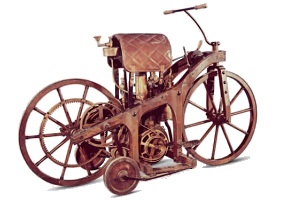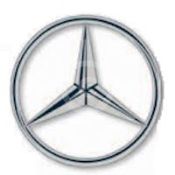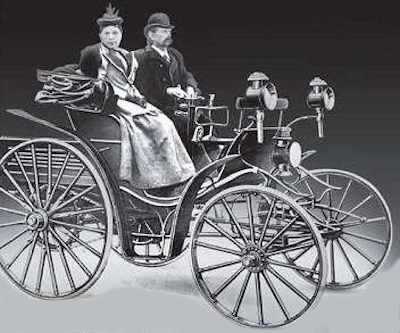The history of Mercedes is also the history of the car itself. The companies founded by the two German pioneers of the internal combustion engine and the automobile – Gottlieb Daimler and Karl Benz – came together to form a marque that now makes some of the world’s most advanced and desirable cars.

Many Automotive Innovators can lay claim to the part they have played in shaping the modern car. But none can equal the contribution of Karl Benz, the man who invented the automobile.
Benz patented his Motorwagen in January 1886, but his spindly three – wheeler – with its single – cylinder, four – stroke internal combustion engine running on coal gas – had spluttered into life on the roads of Mannheim, Germany, the previous year.
By coincidence, Gottlieb Daimler, an engineer based in Canstatt, had made a gas-powered internal combustion engine in 1883.
To demonstrate his engine, Daimler installed it into a primitive motorcycle, which made its first significant trip on November 10, 1885, when Daimler’s son Paul took it for a ride.
Daimler’s installed it into a primitive motorcycle, which made its first significant trip on November 10, 1885, when Daimler’s son Paul took it for a ride. Daimlers first car – like prototype was a four – wheeled vehicle made from an adapted horse – drawn carriage in 1886.
Daimler vehicles went on the market until 1892, but Benz worked hard to put a gas-driven version of his tiller – steered Motorwagen on public sale; he delivered the first to Emile Roger of Paris in 1888.
Benz’s car possessed several features common to every automobile today, including an accelerator, a spark plug, a clutch, and a radiator for water – cooling. In 1893 Benz produced the Viktoria, a four – wheeled car with pivoting axles for better steering. The next year a development of the Viktoria, known as the Velo, became the world’s first production car. It was, however, the Daimler company that set the pace in this transportation revolution – despite the death of its founder in 1900.
Realizing that tall, compact automobiles – such as the 1898 Canstatt-Daimler racer-were inherently unstable, engineer Willhelm Maybach and Paul Daimler designed a new car for 1901. This 35HP model created the template followed by most car makers for decades to come.
Realizing that tall, compact automobiles – such as the 1898 Canstatt-Daimler racer-were inherently unstable, engineer Willhelm Maybach and Paul Daimler designed a new car for 1901. This 35HP model created the template followed by most car makers for decades to come.

Cradled by a chassis of pressed steel, the car’s occupants sat behind the engine, rather than above it. The four-cylinder engine, which had an in – line aluminum crankcase, was located under a hood and behind a honeycomb radiator.The car was also equipped with a gate gearshift, a foot throttle, and a steering wheel on a raked column.
Furthermore, it had a lower center of gravity than any previous vehicle, giving much-improved responsiveness.This 35 hp Daimler car also carried a new brand name – Mercedes. Emile Jellinek, an Austro – Hungarian entrepreneur, had ordered 36 cars from Daimler in return for exclusive marketing rights in several territories. He renamed them Mercedes cars, after his 11 – year – old daughter, and the name quickly replaced that of Daimler.
Sales of Mercedes cars soared, helped by the top – of – the -range 60 hp model of 1903, which featured overhead (instead of side) engine valves. It was the most advanced car on the market, and it immediately inspired imitators. During World War I, the Daimler – Mercedes and Benz companies made military vehicles for the German army.
By this time they had become close rivals, and had forged parallel reputations for high – quality engineering. Benz, with Ferdinand Porsche overseeing design, produced the more exciting cars, including the Blitzen-Benz racer, which held the world land-speed record from 1909 to 1924.
Mercedes, meanwhile, proved adept at building a range of models in several sizes. The recession that hit Germany in the 1920s created high levels of infiation and unemployment, and forced many firms into joint ventures. From being archrivals, Daimler-Mercedes and Benz entered into limited cooperation over some elements of car production and marketing, and began to plan their future strategy together.
The two companies merged in 1926, becoming Daimler – Benz AG, and the cars were marketed under the brand Mercedes – Benz. The new emblem consisted of Benz’s laurel-wreath logo encircling the three-pointed Mercedes star.
The company abandoned all racing for 30 years, and only returned to Formula 1 in the mid-1990s as an engine supplier to McLaren. The McLaren-Mercedes team delivered championships for Mika Häkkinen in 1998 and 1999, and for Lewis Hamilton in 2008.

Traditionally, Mercedes-Benz preferred to expand its operations gradually. In one attempt to broaden its activities, it bought AutoUnion/Audi in 1958, but sold it to Volkswagen in 1965. To move into the small – car market, it backed the Smart city – car venture in 1994 and launched its own A-Class car in 1997 as an upmarket alternative to the Volkswagen Golf. In a bolder move, Mercedes-Benz bought the Chrysler Corporation in 1998. After struggling for eight years to make a viable businessout of the resulting multinational behemoth, it sold both the Chrysler/Dodge and Jeep divisions.
The company was free once again to focus on Mercedes-Benz cars. In motor sport, 1955 proved to be a watershed for Mercedes-Benz: The W154 gave Juan Fangio the World Championship for the second time, but tragedy struck at the Le Mans 24-hour race, where Pierre Levegh’s 300SLR cartwheeled into the crowd, killing 83 spectators. After the war, the occupying powers directed the company to build commercial vehicles to aid the reconstruction effort.
Car production gradually resumed, and by 1949 – when its first new post – war models made their debut – annual output was more than 17,000 cars; by 1958 this had climbed to 100,000 cars. The 1930s helped to consolidate the reputation of Mercedes-Benz cars for luxury and power. The German Third Reich adored the huge Grosser limousines, while playboys delighted in the supercharged 540K, and the W125 Grand Prix car dominated European motor racing. During World War II, when Daimler-Benz’s resources were once again diverted to military ends, around 80 percent of the frm’s manufacturing capacity was bombed.